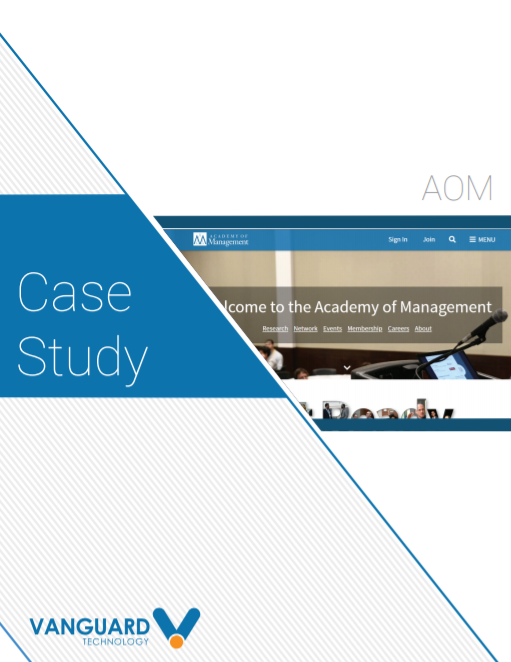Web Smarts - Business Savvy
We’ve been building websites since 1998
We are trusted advisors to Over 50 Active Clients within several industries including associations and nonprofits, healthcare, financial services, retail, B2B and more.

We Are
Trusted
Partners
After we deliver a quality website on time and within your budget, we will be there for when it really counts. We will be proactive, consultative and strategic after we launch your website.

We Are
Integration
Experts
We’ve integrated with virtually every AMS system on the market as well as most LMS, publication, advocacy and career center applications. Our company was founded on custom development.

We build websites that are easy to edit, manage and design using the best content management system on the market, Sitefinity CMS.
We Provide A Full Spectrum Of Services
Our Clients Are Our Partners....
John Wurm

The team at Vanguard helped us think about our digital presence from the perspective and needs of our users, while holding true to the values our organization espouses.
Connect With Us
Improve Your Webcopy

The
Vanguard View
Technology articles about one topic from the perspective of Leadership, Marketing and IT professionals .
CMS: When to Patch and When to Upgrade
Time Vs. Oldness
Time is relentless. It marches on with unfaltering rhythm and consistency. Everything is getting older. The trees, the birds, you, me… and software. But before you have an existential crisis or pack your things to move to the event horizon of a black hole, consider “older” can mean a different amount of time for different things. A great example is how we like to calculate “dog years.” It goes a little like this. My Yellow Labrador is four years old. Multiply this by seven and she is 28 dog years old. This is our attempt to relate to the dog’s stage in life, but they have experienced the same amount of time passing as we have even though they have aged faster comparatively. The same is true for software, but at a much faster rate.
The CMS Aging Rate
Are you still running Microsoft Windows XP or playing Nintendo’s Mario Kart on an N64? While there is some value in nostalgia, you have likely moved on to the latest and greatest software. The latest software likely has better or more features. While the current version of the software may work just fine, developers continue to make new versions to add features and/or changes to provide more value for the product they provide. Not only do these continual upgrades keep you coming back, but it also adds complexity and shortens the life span of your previous version. This is because the software company cannot logistically service all old versions of their software. It would be too overwhelming and inefficient, as the number of users on previous versions of the software decline and differences between version increase. Therefore, software companies slowly phase out support for old versions of their software. For most software, support is retired two to four major versions behind the current version. Most CMSs (Content Management System[s]) release one major version and a few minor versions of their software in a single year. This means one year is equal to about 25 CMS years!
The Difference Between an Upgrade and a Patch
As mentioned previously, the largest benefit to upgrading is the features added or changed within the software. However, an upgrade can also address issues found in previous versions. An upgrade that addresses one or two specific issues found in a major version release of software is often called a patch. You may also hear the term “Hotfix” which is a patch that typically does not require a restart of the software. To better define the difference between what is an upgrade and what is a patch is to understand the purpose behind the upgrade. We’ll define an upgrade as a small or large upgrade that adds additional value to the previous version of the software. A patch, while still an upgrade, is a small upgrade that only addresses an issue(s) with the previous version(s) of the software.
To Patch or Not to Patch, that is the Question
If a full upgrade also fixes the issues addressed by patches, why patch my CMS at all? The answer is that upgrades are significant and take much more time. Full upgrades take many development hours and this effort is increased if your website has any custom features. Your developer will need to test your custom features to ensure that the upgrade did not interfere with any of its actions. On the other hand, patches are typically small and take much less time to implement. Additionally, unless your patch deals directly with correcting something that your custom functionality utilizes, your developer likely will not need to retest any of your custom functionality. This makes patching much more cost effective. Not only does patching take much less time and effort, but they are also timely.
Patches are timely as they usually attempt to correct an outstanding issue before the next version is available. This is most common with security vulnerabilities. This is common for most software and, if you are ever prompted by a piece of software to automatically update itself when a patch is available, always select yes.
I bet the character Rich Donahue (played by William Mapother) in the 2015 movie Blackhat wish he’d updated his PDF viewer.
Patches are not so automatic for your CMS. When a patch is released, speak with your web developer to determine if the patch is necessary, or even applicable to your website. Together, you can determine if you should patch the CMS or wait for the next version to upgrade.
Vanguard Tips & Tricks
We provide helpful hints you never knew you needed for our clients. Check out "Vanguard Tips & Tricks" to learn quick and simple hacks to make managing your website easier than ever.
CMS: When to Patch and When to Upgrade
Time Vs. Oldness
Time is relentless. It marches on with unfaltering rhythm and consistency. Everything is getting older. The trees, the birds, you, me… and software. But before you have an existential crisis or pack your things to move to the event horizon of a black hole, consider “older” can mean a different amount of time for different things. A great example is how we like to calculate “dog years.” It goes a little like this. My Yellow Labrador is four years old. Multiply this by seven and she is 28 dog years old. This is our attempt to relate to the dog’s stage in life, but they have experienced the same amount of time passing as we have even though they have aged faster comparatively. The same is true for software, but at a much faster rate.
The CMS Aging Rate
Are you still running Microsoft Windows XP or playing Nintendo’s Mario Kart on an N64? While there is some value in nostalgia, you have likely moved on to the latest and greatest software. The latest software likely has better or more features. While the current version of the software may work just fine, developers continue to make new versions to add features and/or changes to provide more value for the product they provide. Not only do these continual upgrades keep you coming back, but it also adds complexity and shortens the life span of your previous version. This is because the software company cannot logistically service all old versions of their software. It would be too overwhelming and inefficient, as the number of users on previous versions of the software decline and differences between version increase. Therefore, software companies slowly phase out support for old versions of their software. For most software, support is retired two to four major versions behind the current version. Most CMSs (Content Management System[s]) release one major version and a few minor versions of their software in a single year. This means one year is equal to about 25 CMS years!
The Difference Between an Upgrade and a Patch
As mentioned previously, the largest benefit to upgrading is the features added or changed within the software. However, an upgrade can also address issues found in previous versions. An upgrade that addresses one or two specific issues found in a major version release of software is often called a patch. You may also hear the term “Hotfix” which is a patch that typically does not require a restart of the software. To better define the difference between what is an upgrade and what is a patch is to understand the purpose behind the upgrade. We’ll define an upgrade as a small or large upgrade that adds additional value to the previous version of the software. A patch, while still an upgrade, is a small upgrade that only addresses an issue(s) with the previous version(s) of the software.
To Patch or Not to Patch, that is the Question
If a full upgrade also fixes the issues addressed by patches, why patch my CMS at all? The answer is that upgrades are significant and take much more time. Full upgrades take many development hours and this effort is increased if your website has any custom features. Your developer will need to test your custom features to ensure that the upgrade did not interfere with any of its actions. On the other hand, patches are typically small and take much less time to implement. Additionally, unless your patch deals directly with correcting something that your custom functionality utilizes, your developer likely will not need to retest any of your custom functionality. This makes patching much more cost effective. Not only does patching take much less time and effort, but they are also timely.
Patches are timely as they usually attempt to correct an outstanding issue before the next version is available. This is most common with security vulnerabilities. This is common for most software and, if you are ever prompted by a piece of software to automatically update itself when a patch is available, always select yes.
I bet the character Rich Donahue (played by William Mapother) in the 2015 movie Blackhat wish he’d updated his PDF viewer.
Patches are not so automatic for your CMS. When a patch is released, speak with your web developer to determine if the patch is necessary, or even applicable to your website. Together, you can determine if you should patch the CMS or wait for the next version to upgrade.
Case Studies
Vanguard conducts thorough preliminary investigative work to ensure your website is built to cater specifically to your target audience and meet your organization’s goals. Check out some of the case studies on some of our most recent client success stories.
What Can Vanguard Do For You?
As your organization grows and evolves, your website should as well. Whether you are looking to generate more traffic, implement custom functionality, mobile compatibility, integrate your systems, or give your site a complete redesign, Vanguard Technology is your go-to web partner. Reach out to us with your current concerns with your website, and our experts will happily provide a solution.










Leave a commentOrder by
Newest on top Oldest on top